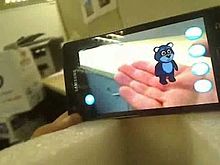A recent article by Wayne LaBar, the founder and principal at Alchemy Studios, outlined some of the growing trends in interactivity in museums...and got me to thinking: Are these also trends we are seeing in zoos and aquariums? If not, should they be? Certainly, interactivity in experience and educational opportunities are important aspects of zoo design. However, our industry may not lead the charge due to the simple fact that zoo visitors come to see animals primarily. Interactivity adds to the experience, elevates the excitement, and could serve as an educational platform, but in the end, guests would be happy just getting to see animals. Museums face a more difficult challenge in communicating often abstract concepts to their visitors without the benefit of a cute furry face, and thus seem to be the driving force of innovation on interactivity and interpretation in general.
Let's take a look at the current trends.
Certainly one of the largest movements occurring in children’s museums and science centers is the creation of Tinkering or Making spaces. This is a movement that originates from the work done by Make magazine and their affiliated “Maker Faires.” (www.makerfaire.com) As museums witnessed the creativity and the direct interaction that the public has with STEM (science, technology engineering and math) content, an essential need for museums to attract audience and funding, Tinkering/Maker spaces are popping up in many places. A Tinkering space is a place where visitors are allowed to build, create and tinker with low-end technology, use real tools and explore the concept of making something. These are usually staffed spaces although some are trying to explore minimizing staff engagement. Often, special events, fairs and other programs are being held in connection with these spaces. A key aspect of this is that these spaces do not require extensive design and development schedules and costs. They are a marriage of exhibit and program, where the activity is more important than the environment. The Exploratorium with their Tinkering Studio (blogs.exploratorium.edu/tinkering/) , New York Hall of Science who hosts the NYC Maker Faire and issued a report (www.nysci.org/learn/research/maker_faire_workshop) , and the Pittsburgh Children’s Museum MAKESHOP (pittsburghkids.org/exhibits/makeshop) are some of the leaders in this endeavor.
This one is somewhat limited in zoos and aquariums. I've heard about learning to basketweave or make jewelry and enrichment days where guests can make items for the animals (discussed further below), but generally the act of 'making' isn't the first thing that comes to mind when discussing the animal world. However, it is an interesting topic in that part of our challenge in zoo design is to create empathy. Many animals are, in fact, 'makers.' Birds build all sorts of nests in a variety of sizes, shapes and materials. Beavers make elaborate dams. Primates make and use tools. Even fish make nests! Why not create stations where these things can be experienced and explored in zoos?
Collaborative Exhibits & Events
In the constant search for innovative (yet budget-conscious) exhibits and interactivity, museums are increasingly looking to create ways in which people can interact by engaging with artists, groups and community organizations. Exhibitions based on this approach tend to have interactivity that may be more experimental or short-term, perhaps built around a weekend event or happening. A benefit of this type of low-impact interactivity is the opportunity to try things that are different and not necessarily built to the fabrication and durability standards that would define more traditional exhibits. Additionally, by reflecting engagement with community groups and other organizations, the exhibit becomes more social, and the social networks of these organizations, both physical and electronic, become engaged with the exhibits and potentially become part of the exhibitions themselves. One place exploring this direction is the Santa Cruz Museum of Art and History. Check out their event at (www.santacruzmah.org/events/) and read Nina Simon’s article in the latest NAME Exhibitionist issue.
The growing trend of Enrichment Days are what comes to mind in relation to collaborative events. Guests are encouraged to create and facilitate enrichment throughout the zoo, and in doing so, interact with keepers, docents and animals at a level not experienced on a normal trip to the zoo. I'm very curious about the effect of these special days as they exist now on visitor experience and how we can build from the basic idea to expand in a more socially engaging way as indicated by LaBar. Other events such as the now commonplace food / beer / music fundraising festivals (oftentimes called Zoofari) linger on the edge of being a collaborative event, but lack an integrated conservation / education message that could be leveraged during these gatherings.
New Interfaces
Certainly, an area that piques everyone’s interest in the interactivity field is devising new ways for people to engage with digital content or digital displays through more physical interfaces. We have seen a move away from the idea of keyboard-and-mouse to touchscreen to touch tables and now Kinect or Kinect-like interfaces. This outlines an evolution of the interface becoming more and more physical, more fully-body engaging and with more seamless physical/virtual experience. Over the past year, we have seen interest in new and innovative ways to engage people physically but also marrying that with digital content. Examples include the “Firewall” by Aaron Sherwood created in collaboration with Michael Allison, “Water Light Graffiti” done under the Digitalarti Artlab by the artist Antonin Fourneau, or the work done by ART+COM. In part, this is driven by the need for museums to provide experiences that cannot be duplicated at home. The interface advances also reflect the evolution of museum experiences moving into the home. These marriages of art, computer, physical world and content create interactivity and experiences that can’t be duplicated on your Xbox.
more fully-body engaging and with more seamless physical/virtual experience. Over the past year, we have seen interest in new and innovative ways to engage people physically but also marrying that with digital content. Examples include the “Firewall” by Aaron Sherwood created in collaboration with Michael Allison, “Water Light Graffiti” done under the Digitalarti Artlab by the artist Antonin Fourneau, or the work done by ART+COM. In part, this is driven by the need for museums to provide experiences that cannot be duplicated at home. The interface advances also reflect the evolution of museum experiences moving into the home. These marriages of art, computer, physical world and content create interactivity and experiences that can’t be duplicated on your Xbox.
 Interfaces are all over the map in zoos and aquariums. Partially due to the lack of budget and partially due to durability issues, zoos and aquariums vary in their usage of technology. Aquariums, with their somewhat controlled indoor environment, seem to be much more willing to embrace such things as touchscreens (seen in Georgia Aquarium as far back as 2005) and full-body Kinect-like interfaces. As technology moves forward--driving prices down and durability up, I am confident we'll see an increase in these creative interfaces not only for interpretation at zoos and aquariums but also as part of the general guest experience.
Interfaces are all over the map in zoos and aquariums. Partially due to the lack of budget and partially due to durability issues, zoos and aquariums vary in their usage of technology. Aquariums, with their somewhat controlled indoor environment, seem to be much more willing to embrace such things as touchscreens (seen in Georgia Aquarium as far back as 2005) and full-body Kinect-like interfaces. As technology moves forward--driving prices down and durability up, I am confident we'll see an increase in these creative interfaces not only for interpretation at zoos and aquariums but also as part of the general guest experience.
And what about the interactivity of animals and people? This has been a growing trend in zoos and aquariums over the past decade with the increasing popularity of swim-with dolphins and sea lions, lorikeet nectar feeding and ray touches among many others. These 'responsible' interactions are only going to become more prevalent.
Mobile Individuality
The world of mobile computing has been transformed over the past five years with the increasing size of and sophistication of smart phones, the acceptance of tablets, and the growing ubiquity of internet access through cellular plans or freely available wifi. Museums were quick to adopt these technologies as part of the visitor experience, and now they have become almost a necessary part of interactivity strategy for an exhibition or institution. Despite this, the field still struggles with what is the best way to use these technologies and how to integrate them into the exhibition form. For some collections-based exhibitions, they may be the principle interactivity, while a device at an interactive exhibition might actually be an obstacle to visitor experience. As our field continues to explore how to best apply new technologies, some of the more exciting experiments relate to how these devices might personalize everyone’s experience. For example, work is ongoing on enhancing personal instruction as part of school trips, accessing data through NFC technology, and integrating augmented reality into an experience. This personalization will certainly be another ongoing trend in interactivity over the coming year and beyond. Check out work being done at the Minnesota Historical Society in their Education Department with their new exhibition Then Now Wow (minnesotahistorycenter.org/exhibits/then-now-wow) with school groups talked about , The Australian Museum and the work lead by Lynda Kelly (australianmuseum.net.au/staff/lynda-kelly) and the Science Museum of London and their augmented reality with James May (www.sciencemuseum.org.uk/visitmuseum/jamesmay).
Similar to the interface issue, mobile media is on the cusp of exploding onto the zoo and aquarium front. Most zoos acknowledge the desire to tap into this resource--the ability to enhance a visitor's experience through augmented reality as well as provide deeper educational options to those that are interested in lieu of physical graphics / signage--but are limited by the steep initial cost of development. The upside to the cost, however, is once the initial programs are developed, costs are limited to content creation--the same as would be with any other technology, and the operational costs will be much less than most conventional (physical) content delivery methods. Plus, content can be changed out immediately for a fresh and repeatable experience.
zoos acknowledge the desire to tap into this resource--the ability to enhance a visitor's experience through augmented reality as well as provide deeper educational options to those that are interested in lieu of physical graphics / signage--but are limited by the steep initial cost of development. The upside to the cost, however, is once the initial programs are developed, costs are limited to content creation--the same as would be with any other technology, and the operational costs will be much less than most conventional (physical) content delivery methods. Plus, content can be changed out immediately for a fresh and repeatable experience.






















